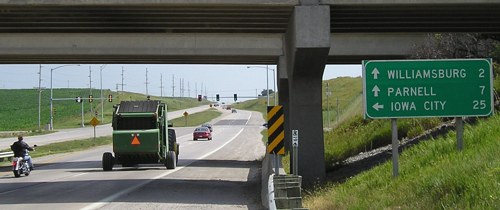Over the past five years, guide signs at Iowa’s interstate interchanges have been revamped with an eye for modern-day driving needs. The last major stretches of interstate will be switching over this summer, and the style will spread to other four-lane roads as replacement cycles warrant.
Since the beginnings of the interstate highway system in Iowa, there had been a standard pattern at cross roads. Each interchange had independent shields arranged on poles/brackets, with mileages given to two “control cities” (major cities on the freeway) and often a third location on the intersecting route. If the intersecting route was a state or US highway, a shield indicating such would be included in at least one assembly. Examples are shown below:


This style was in marked contrast to Minnesota, Illinois, and Missouri, all of which used at least one large, single-panel BGS-type sign for interchanges, and none of which included distances.
Starting in 2009, the Iowa Department of Transportation began moving away from this form. The 2009 Manual for Uniform Traffic Control Devices, or MUTCD, omits inclusion of mileage at interstate crossroads. The specifications overall use larger (Clearview) letters, and there is obviously a greater visibility of a single-panel green sign than individual shields. For more details, click on the jump.
Kurtis Younkin of the DOT’s Office of Traffic and Safety says that in his opinion, the new method “reduces information overload.” Consider the mileage sign above. It contains six discrete pieces of information:
- Exira is ahead.
- Exira is 13 miles away.
- Council Bluffs (that is, the turn for it) is ahead. A second sign will indicate the turn for C.B.
- Council Bluffs is 66 miles away.
- Des Moines is to the right.
- Des Moines is 63 miles away.
The new style of mileage guide sign only has two:
- Des Moines is to the right.
- Council Bluffs is ahead. (Again, there is a follow-up sign indicating the turn for the second city.)
This changeover also means a significant decrease in the number of freestanding interstate shields in Iowa. From now on, they will only be used as reassurance shields on the route itself, and will include the state name. (The shields on panels do not.)
There is one other notable change to Iowa’s interstate signage with this move: St. Paul and Iowa City will no longer be included as alternate control cities on I-35 and I-80, respectively. Every sign north or east of Des Moines will say only Minneapolis or Davenport. So, for example, this mileage sign at IA 149’s south end

has been removed in favor of a larger sign saying “80 East Davenport Next Left.” (I doubt “Twin Cities” and “Quad Cities” were ever really options.)
The wholesale sign replacement projects made for short lifespans for previous signs at a few places, including every interchange at I-80 where US 6 shields weren’t added until 2003. There is already at least one interchange where this new style is out of date: Signs on IA 130 at I-80 do not account for the US 61 reroute around Davenport. That shows a potential weakness in this new style: If one road designation changes, the entire large sign must be replaced.
The last significant rural segments of interstate to get this treatment are I-35 north of US 20 and all of I-380 outside of Cedar Rapids. That leaves I-280, which could be waiting until reconstruction of its lanes is done, or it could be because “I-80” has been the north/west control city there and that could be tricky to translate to the new style. For non-interstates, new US 20 in western Iowa already has the new style (they went so far as to green out distances to Sioux City and Fort Dodge at IA 4), and it will be the default for all new interchanges. There have yet to be any large exit-to-exit replacement projects for those roads, and/but many of them have currently existing shields that should be good for a decade or more.
In my opinion, I am sad to see the distances go. It made Iowa a little different, and a little more informative. This project just goes to show that even things you think are permanent parts of the transportation landscape are subject to change. It also makes a whole lot of pictures on this website final, historical snapshots of the way Iowa signs used to be, all the way back to the beginnings of the interstate era.
